 |
Senenmut |
last update:
18.10.2009
|
| |
Senenmut and Hatshepsut
|
|
| Doubtless Senenmut has made a great career. In the end,
as a son of unimportant parents he got in the center of the power. The
beginning of his career lies in the darkness, possibly he started as a
soldier, but it led him via positions like that of a "Steward of the God's Wife" and
"Steward of the King's Daughter", the position of the tutor (i.e.
"nurse") of the "King's Daughter" Neferu-Ra,
and among other
positions at least in the office of the "Stewardship of the
Property of Amun". |
|
Naturally, this career has developed in the shade of the sovereign(s). On account
of the plenty of privileges for and the accumulation of offices
by Senenmut it has been tried over and over again to pull the supposed
protection by Hatshepsut down to the level of a sexual relationship. Naturally,
a sexual relation between Hatschepsut and Senenmut cannot be excluded but
vice versa the listed "indications" appear rather arbitrarily
interpreted - or even chauvinistic.
|
|
For example, the cubic block statues (see below) representing Senenmut together
with Neferu-Ra, like the one from Berlin (see also:
Cryptograms
on Tutor-statues of Senenmut), are often
interpreted as a hint to a fatherhood of Senenmut, because in this
representation he wraps his arms around the princess like a father who is protecting his child.
|
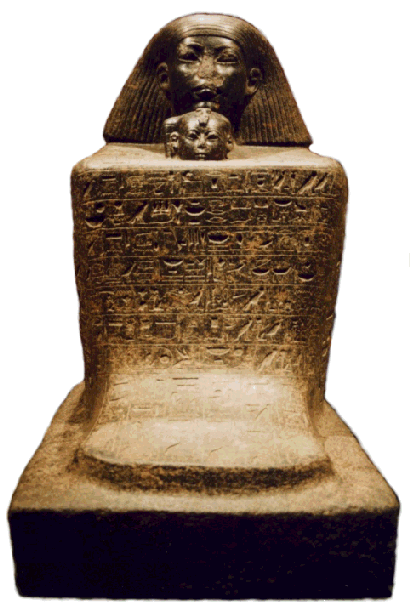
|
Block statue of Senenmut and Neferu-Ra, Egyptian Museum,
Berlin no. 2296
|
|
In fact, over and over again it is ignored hat the tutors (= nurses)
were especially appreciated at the past as demonstrated by the
"privileges" given to Sat-Ra, the nurse of Hatshepsut. She was
given a tomb in the Valley of Kings and a seated statue which shows
her holding young Hatshepsut on on her lap. This statue presumably had been put up
in the Chapel of Hathor at Djeser djeseru.
|
|
Over and over again in this discussion appear the erotic graffiti from the
grotto above the temple of Hatshepsut, Djeser djeseru. The grotto is located in
the northern wall of the valley. It is the most eastern chamber in a row of tomb
chapels from the 11. Dynasty (Wente, in 1984; see in addition also
Porter&Moss, Vol. I-2, p. 658, graffiti in Deir el-Bahari where the
grotto is called tomb 504). The chamber is incomplete and served in the
new empire obviously as a "lounge" for officials and priests of
the neighboring temples
|
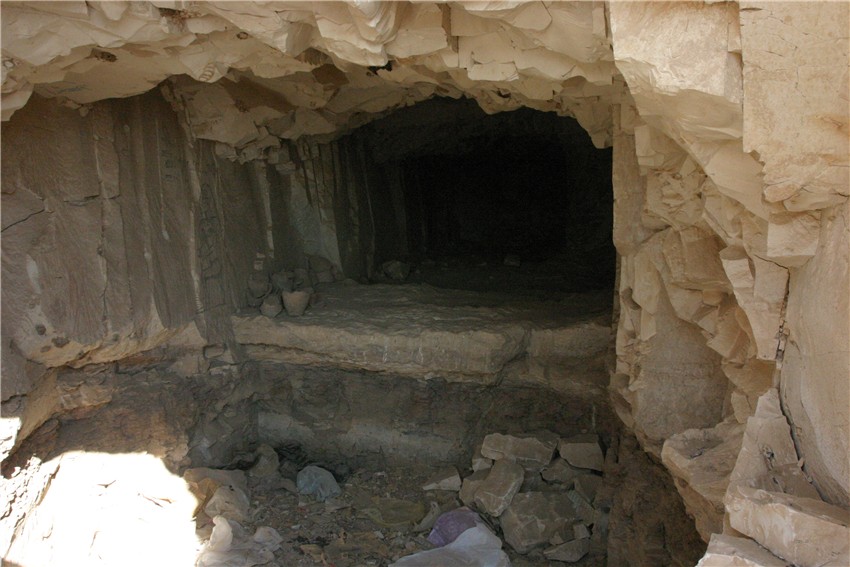
|
According to Wente (1984) numerous representations are found in the grotto, even
the ceiling has been used as a painting surface. The erotic graffiti are found
beside the stele-shaped graffito of Neferhotep
on the eastern
wall. This offered - as the only wall in the grotto - a smooth surface
simply to be painted. All the other graffiti have been painted on rough
surfaces and partly could be painted only in extremely uncomfortable
position. For example, the ceiling shows an (according to Wente, in 1984,
unpublished) graffito of a certain Nebwa, priests in the funerary temple
of the Thutmosis I. Thus, Wente concluded that the graffiti on the east
wall should date early among the other paintings or in the grotto.
|
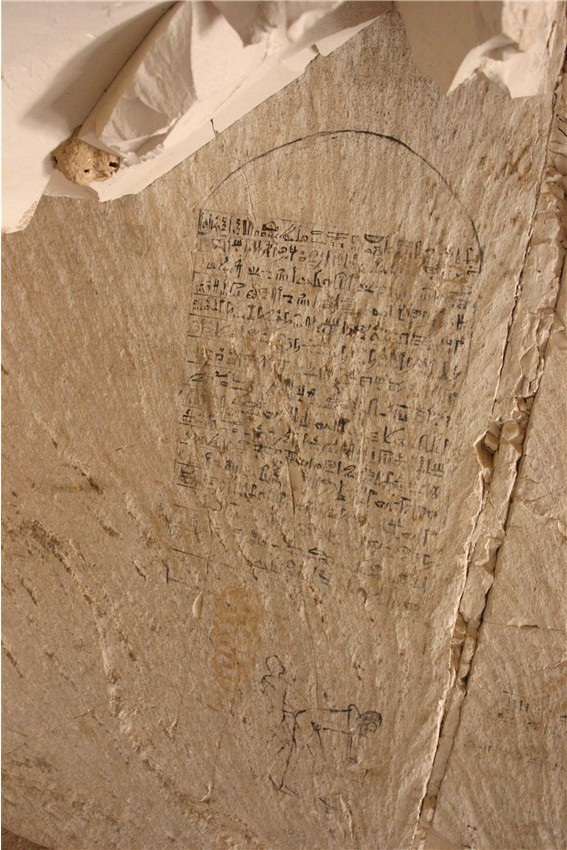
|
The photo above shows the graffito of Neferhotep and below that a couple in a
sexual intercourse.
|
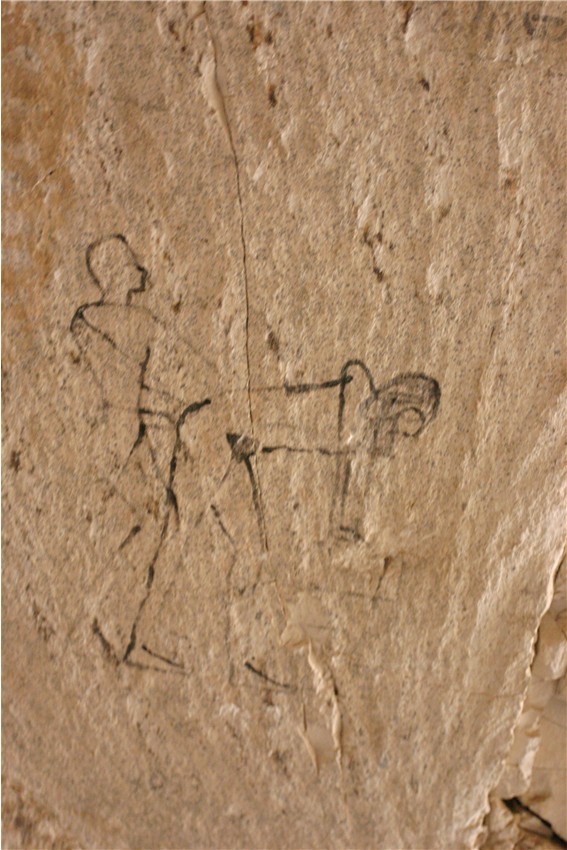
|
This photo shows the couple performing a coitus "a tergo". Noticeable are
the large wig of the lady and her missing breasts. The scene is about 25 cms high.
|
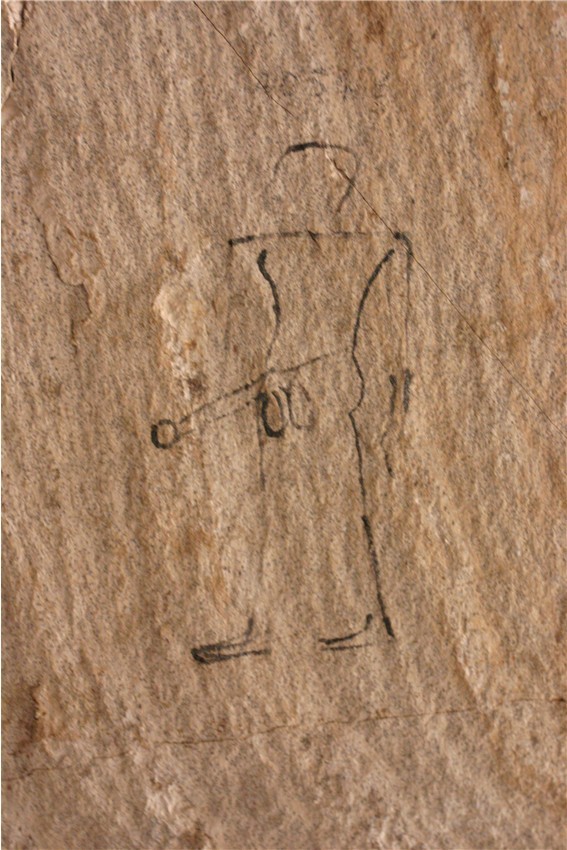
|
Right of the graffito of Neferhotep two males are depicted. Above the first male another stele-like inscription was planned but not finished.
The 2nd smaller man far right is shown presenting an oversized erected phallus.
|
|
Viewing the east-wall it appears noticeable that the couple performing the
coitus has no epigraphs. In contrast, however, several inscriptions (according
to Wente 4 are found in front and one above the head of the larger man on the right). The inscriptions in front of the large figure read:
1 - The third prophet of Amun Pahu, born of the lady of the house ....
2 - The third prophet of Amun in Djeser djeseru Aapehty, begotten
of the scribe, god's father of Amun, who has access to the mysteries
..... in Karnak, Merymaat
3 - The second prophet of Amun in Djeser djeseru - he is one who has
made his reputation - the scribe .... Amenemhat, born of the lady of the
house, Sat-....
4 - There came ...
|
|
These four inscriptions are related to priests who above all served in
the temple Djeser djeseru. Romer (1982) believes that he is be able
to identify Senenmut in the figure. Wente contradicts Romer, because in
the inscription above the figure neither the name nor the title of the
Senenmut are mentioned. Wente thinks that the preserved traces of the text
possibly might be read as the title "stone mason".
|
|
Taking all the information together the following "picture" arises:
|
|
1. - the couple performing the coitus has no epigraph
|
|
2. - the texts surroundings the erotic scenes mention officials or priests, their
names, and occasionally the temple to which they belonged
|
|
3. - none of the adjacent texts give any connection to (or mention of the
names of) Hatshepsut or Senenmut
|
|
4. - between the texts and the representations no other connections can be
produced definitely except that they are painted next to each other
|
|
5. - hence, all personal identification are based on interpretations of
the representations or supposition, e.g.
|
|
5.1 - because the erotic scenes stand beside the texts (which do not
contain any textual connection to the erotic scenes), it is concluded that the scenes and the texts were
"painted" at the same time
|
|
5.2 - the female of the couple wears a hairstyle, that looks like the wig
of a queen - hence, it "must" be Hatshepsut
|
|
5.3 - the tall man in the middle wears an unusual cap (or hat) as it was
worn occasionally by supervisors - thus, it "must" be Senenmut
|
|
5.4 - likewise, the little naked man behind the lady "must" be Senenmut,
because the drawing of his head resembles the drawing of the head with cap
of the tall man
|
|
Romer "recognized" in the couple a representation of Hatshepsut
and Senenmut, concerning Hatshepsut Wente agreed with him, however, he did
not see a connection to Senenmut.
|
|
Also interesting are the further "conclusions" of Romer and Wente after they finally
had made
up their mind regarding the identification of the persons
"involved":
|
6.1 - from the Egyptian iconography one expects in the representation of a
queen not only a royal wig but also the royal uraeus, its absence in the
scene must explained:
- thus, it was concluded that the "artist" was
intentionally disrespectful by drawing the queen without the royal
insignia
|
6.2 - because the absence of the uraeus had to be explained, there is
also a need to explain the absence of the breasts:
- here it was
concluded that the "artist" commented on the ambiguity of the fact
that a woman sat on Pharaoh's throne instead of a "mighty bull"
|
|
Hence, both, Romer and Wente, got the picture of a political allusion on
the ambiguity of the fact that a woman has usurped the throne of the
"mighty bull " - but no representation of a real relation
between Hatshepsut and Senenmut.
|
|




